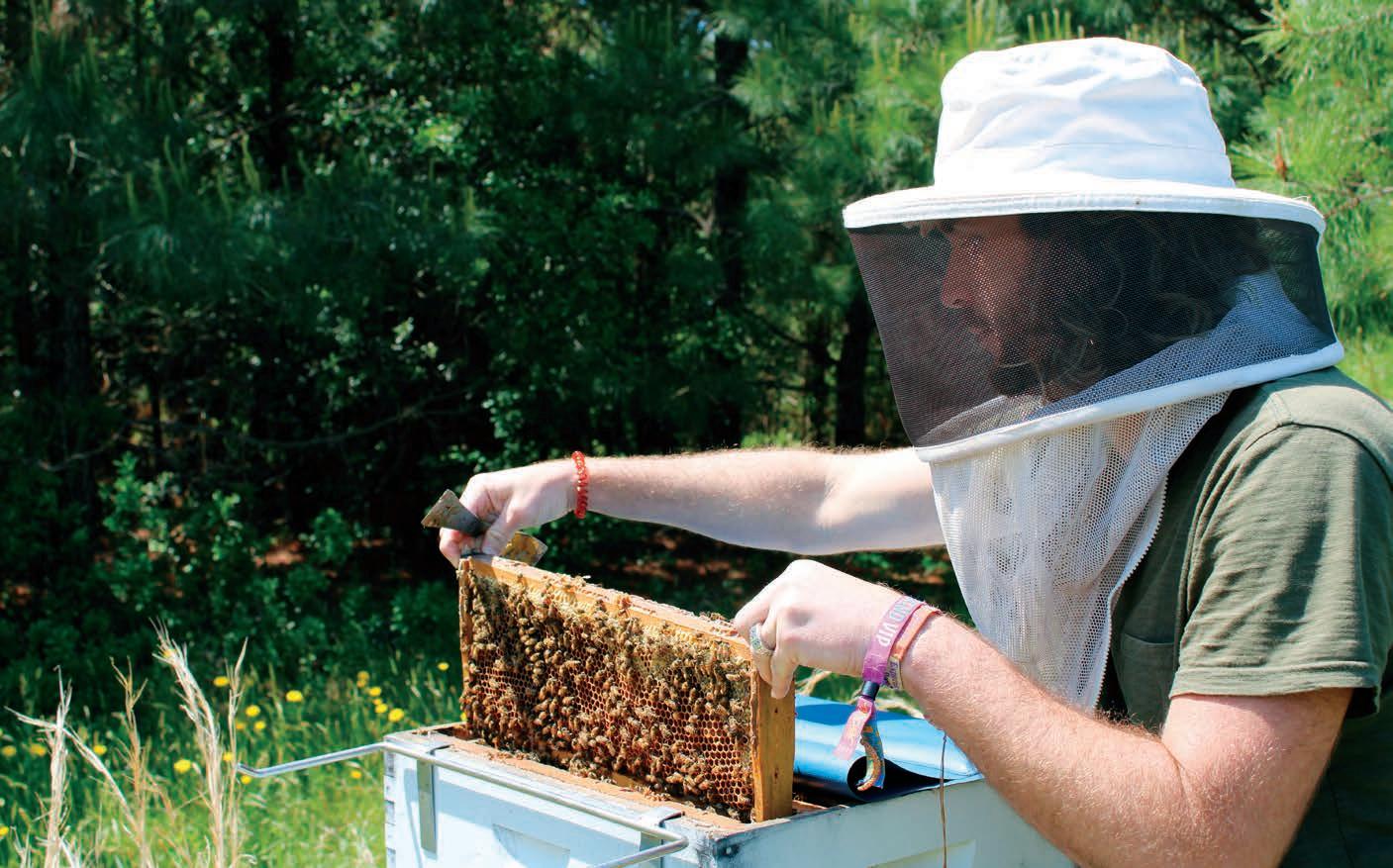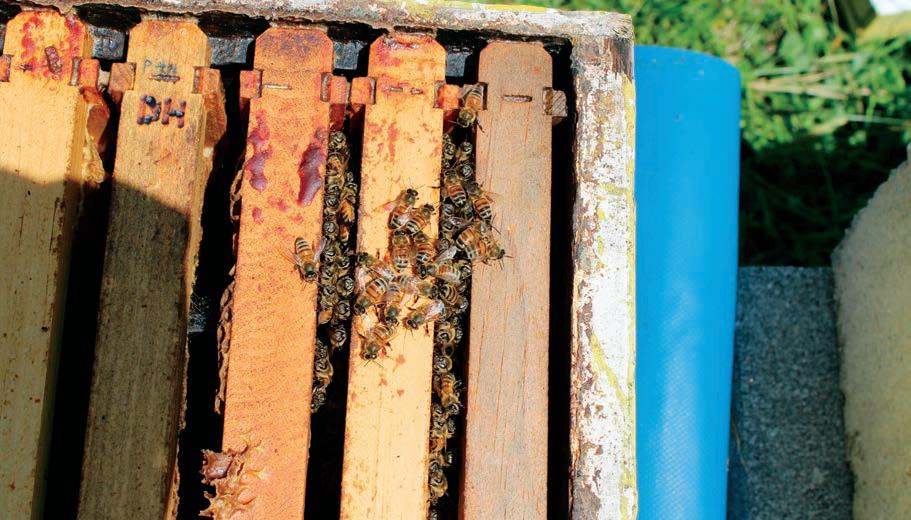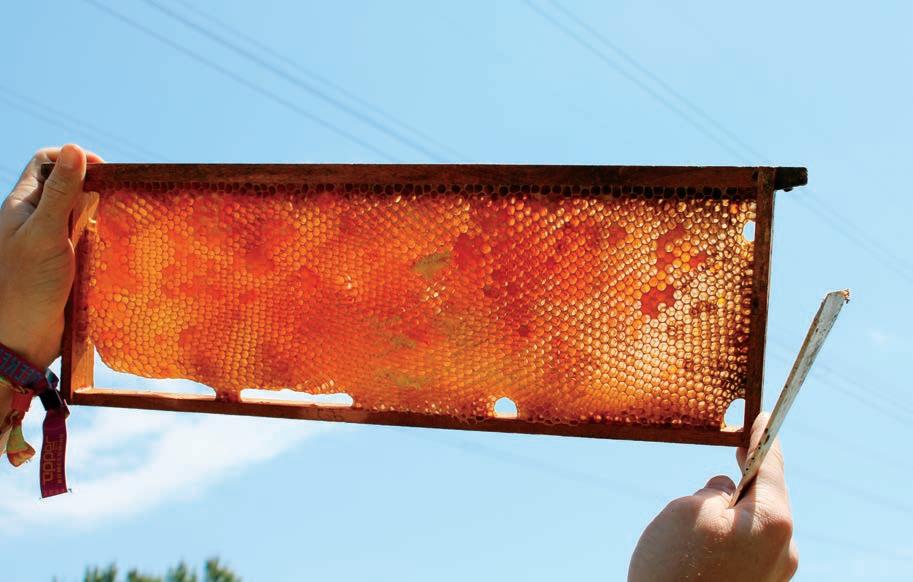
8 minute read
Beekeeping: More than just the honey





Beekeeping
More than just the honey
In Lower Currituck, Dalton Hyde pulls off the highway onto a gravel road, driving slowly until he reaches a sprawling green field dotted with dandelions. As he turns off the ignition, all is quiet. The grass is tall. He makes his way to several plainly constructed wooden boxes. To him, precious boxes. Within the boxes are his bee hives, containing tens of thousands of the small pollinators.
After lighting some dry pine straw to create smoke to alert them, he gingerly lifts the lid to engage with his bees. They are aware of his presence, but they aren’t agitated. He moves slowly, carefully, reaching into the box to remove a “frame” – or wooden structural element that holds the honeycomb. Thousands of bees crawl around the frame, their perfect honeycomb pattern evident in the afternoon light. The queen is there, but well protected, and Hyde can’t spot her today. One by one, he removes and inspects each frame, checking for intrusive moth larvae, changes in the honeycomb, and generally looking for anything that could affect the health of his hives. The process can take several hours. Sure, it’s about honey. But for Dalton Hyde and most beekeepers, it’s about so much more.
The Coastland Times caught up with Hyde for a Q&A session about all things bees, honey, getting stung and why he’s drawn to the unique art of beekeeping.

by Summer Stevens
1. How did you get into beekeeping?
I began my beekeeping journey in 2015. My grandmother, Thelma Ganyon, told me about a beekeeping group she had come across that I should check out. She’s the one in my life that cultivated my personal interests in nature, landscaping/plants and accompanying animals and pollinators. I attended my first meeting and was greeted by Denise Deacon, one of the founders of the Outer Banks Beekeepers Guild and its first president. Eventually, she became my mentor in all things bees, and I would not
be as advanced without her.
2. Walk me through a typical day in the busy season…
Well with most things in our area, there are not just busy days but a busy season! I would say that late winter into springtime is the most chaotic when you are coming out of winter and preparing for the honey flow.
Many may think winter is a slow time for bees, but it’s when you should be planning and preparing for your season. It’s the time to lay out your actions, clean existing equipment, purchase/build new equipment and assemble your go bags for swarm calls! I’m sure many beekeepers agree with me when I say most long for the fair-weather days when they can casually observe their hive and its processes… watching a hive is a mesmerizing experience.
Once spring arrives, you’re trying to find fair weather to crack open your hives and take note of their state. You’re checking for the size/quantity of bees, what stores/ resources they have left (if any), and is the queen around and viable, etc.
As spring progresses, it enters swarm season… a natural phenomenon which is when a hive splits itself to reproduce. When they do this, it’s an opportunity to catch the departing hive and reduce your apiary’s losses/setbacks. A hive that has swarmed can be delayed in honey production by up to four weeks (if lucky). We get calls about swarms often during this period, and it can be a mad dash to work out who can respond and how to successfully capture said swarms without issue. You can minimize losses by preparing and staging a swarm trap, a little box built to specifications that honeybees search for when seeking a new home.
Lastly, ensuring your hive supers and frames are all assembled correctly with some sort of foundation for the bees to build off is essential. Once a healthy hive gets going in a flow, it can fill a super in 7-10 days… this period is when you should be monitoring your hives closely to prevent lack of space for incoming resources, laying, etc. Not giving them enough room to bring in a healthy honey harvest can lead to crowding and thus swarming.

Summer Stevens photo
This healthy hive, comprised of tens of thousands of bees, is busy protecting the queen and making honey.
3. How many hives do you have?
I currently have about four hives going… had six last year but lost two over the winter. I’m hoping to increase those numbers going forward as I endeavor to provide myself, friends/family, locals, and visitors with a taste of NE NC’s flora.
4. How do you feel about getting stung?
HAHA – Well, most people are wary of such encounters, but as a beekeeper, you learn to brush them off. Not that there aren’t some that land in an awful spot (see nose), stick a little worse, or take longer to heal… yet sometimes they are welcome, as there are suggested benefits from bee venom, along with noted therapeutic effects provided by the sting. I try to see them as learning experiences about what actions I just conducted that resulted in that sting or why that bee felt its hive was in such jeopardy that it sacrificed its life for it? This line of questioning is good to employ in one’s beekeeping journey… Is what I’m doing good for the bees or good for the beekeeper?
5. How much honey do you collect every year?
Not enough! HAHA – To be fair, honey harvest can be fickle… there are many factors that affect a honey crop. A full-frame of honey can be from 6-10 lbs., you have 8-10 frames per super, with at least two supers and you’re looking at approximately 100 lbs. Other times it can be much, much less or even none at all. It’s critical that a hive is left with enough honey to survive on its own, in order to be able to produce more. Leaving one full super of honey is suggested. While I have yet to yield a harvest that’s considered massive, we have had members of the OBBG harvest 500+ lbs. of honey one spring!
6. Why should people get involved with beekeeping? 7. Can an area get saturated or is there always room for more beekeepers?
People should only get involved if they are truly prepared for everything that comes with it. I spent an entire year attending meetings before getting my first hive. Many think it’s an easy pastime but it’s an active hobby that easily compares to a part-time job. You have to learn so much about the animal you’re caring for – its nature, behavior, and anatomy. Many will tell you that even after years of keeping bees, there is always something new to learn or observe. I would say that it’s vital that we acknowledge the struggle of pollinators of every kind, not just the ones that produce a honey crop that supports an entire industry, but on a local/ regional level, we must do what we can to support our local ecosystem of bumblebees, butterflies, moths, wasps, and honeybees.
Absolutely, an area CAN be saturated by the number of apiaries in it. Honeybees usually forage within a few mile radius around their hive, so as not to attract predators to its location. With that in mind, each morning the entire foraging force zips out seeking nectar, pollen, and propolis… if you have multiple hives, they are all competing for the same local resources. Add in a bunch of neighbors with hives doing the same thing, and you get an area that’s unable to produce enough resources. While that’s not usually the case with hobbyists or backyard keepers, it can be when near large-scale/commercial apiaries. I believe one study showed that when left to their own device, hives proliferate until there’s about one hive per square mile. Which is fascinating isn’t it… how do they know or figure out their locale’s population density?

Summer Stevens photo
Dalton Hyde inspects each frame of his hive for bee health, productivity, and potential problems.
8. How much space or acreage do you need to keep bees? Is it practical for most on the OBX?
Great question and usually one of the first things a person figures out when getting started… Where do I put them? First and foremost, ALWAYS check with state, county, townships, and neighborhood laws to ensure all your preparation isn’t for naught. Luckily, NC legislation protects the right of a beekeeper to have up to five hives in their yard, and the only township that has further restrictions on the practice is Manteo. Southern Shores proposed some alarming updates to its laws last year, but those were benched I believe. After confirming no laws are hindering you, give your neighbors a heads up… bees make people nervous and it’s smart to educate those near you of common behaviors bees exhibit like seeking water from a pool/pond/birdbath to swarming in the spring. So many people think they want to attack when the act of stinging someone extinguishes its own life, its last resort. It doesn’t take much space at all for one or even four hives, as they are small and stackable. The size of a normal yard can do, but you want to take some factors into consideration such as the direction of the sun, wind speeds, flooding concerns, etc. Space for hive placement doesn’t take much, but you’ll want to consider what the few miles around the hive have to offer… this is where more space the better! Ask yourself what comprises the forage area for my bees? Is it made up of city/concrete, natural landscape, residential gardens, agricultural land, urban or rural? If agricultural, are they managed with chemicals that could harm or kill my bees? If the answer is yes or I don’t know, you’ll want to explore some of the options and tools out there to assist with concerns of that nature.










